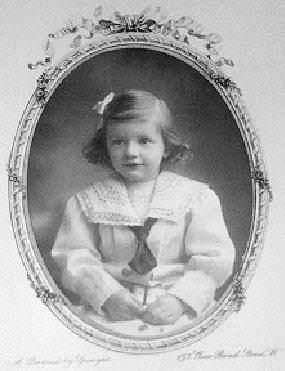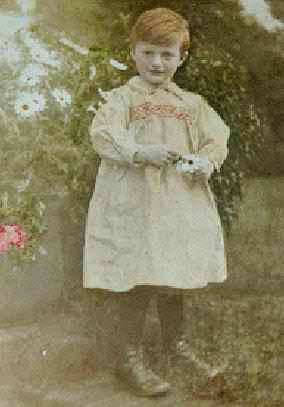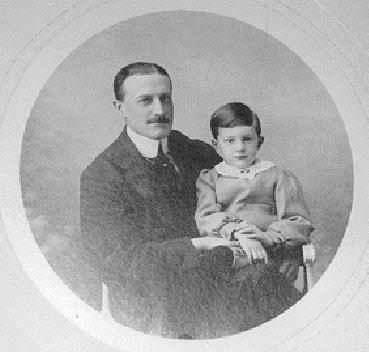
Figure 1.--A about age 3 Christian had long hair which he wore with a hair bow. He appears to be wearing a dress with lacy sailor styling.


Figure 1.--A about age 3 Christian had long hair which he wore with a hair bow. He appears to be wearing a dress with lacy sailor styling. |
English composer Philip Christian Darnton was born near in North Yorkshire near Leeds on October 30, 1905. The family had a German title since 1715 and were related to two families of peers: the Holdens and the Illingworths. John Edward von Schunck, Christopher's father, changed his name to Darnton just before World War I. The aff luent family was extremely well-off and Christian was educated at home by a governess until he was 9 years old. It was at this time that he began composing. He was not allowed to attend public school but spent four years at a small preparatory school near Rottingdean. Until he started his prep school, he had led a sheltered lfe at home. He found attending this boarding school to be a traumatic experience, so his partents must have decide that a public school (exclusive private school) education was not appropriate for him. Early photographs reveal that he wore dresses untill he was 5 years old. A biographer writes that "... to all intents and purposes, treated as a girl until he was about five". HBC is not sure that this is correct, but he did wear dress and had long hair. His mother had a very strong personality, believing that he would be a musician if she played the organ as frequently as possible during her pregnancy. It cannot be doubted that she had a significant influence on her son's development, The family traveled widely. While he behan composing at 9 years of age, he did not perform as a child.
English composer Philip Christian Darnton was born near in North Yorkshire near Leeds on October 30, 1905. The family had a German title since 1715. The family was ennobled to a Barony of the Holy Roman Empire in 1715. They were also related to two families of English peers: the Holdens and the Illingworths. John Edward von Schunckm Christian's father, just before World War I (1914-18), changed the family's name to Darnton. Many English families, including the Royal Family, changed their names during World War I. This avoided anti-German sentiments, but his father did it primarily to meet the terms of his mother's will.
His mother was a formidable character with strongly held beliefs. She thought, for example, that her son would become a musician if she just played the organ as much as as possible while she was pregnant. She had a significant impact on Christain.

Figure 2.--Christian at age 5 wore smocks for play around the house. Notice the smocking on his smock. He wears his smock with long dark stockings. |
The Darntons were a very well to do family. They could afford a governess fofr Christain. They also travelled a lot and Christian went on two world tours.
As a young boy Christian wore dresses and had long hair. A biographer reports, "Early photographs reveal that he was, to all intents and purposes, treated as a girl until he was about five." This judgement was based on the photographs of Christian. HBC believes that it is unfair to say that because he wiore dresses and had lng hair does not mean that he was treated like a girl. It was quite common for young boys to be outfitted in dresses. This was still quite commibn in the 1900s, but had begun to decline by the 1910s. More is need to make such a judgement than just looking at the family photograph.
At age 3 Christian was wearing dresses. The portrait shown here has him in a dress with sailor styling, but rather than the traditional stripped "V" colar it has lace trim. It looks like a white dress. I'm not sure when he was breeched. He was wearing smovks at age 5, but it is not clear what he was wearing under his smock.
A snap shot talen when he was about 5 years old shows him wearing a smock. The colorized print shows that it was a yellow smock. As this was not an actual photograph we do not know how acurate the colorization was, but presumably some effort was made ro replicate his hair color and smock color. He wears long black stockings with his smock. I'm not sure what kind of pants.

Figure 3.--Christian is seen here at 6-7 years with his father. He appears to be wering some kind of back buttoning tunic with kneepants and long stockings. |
The third outfit is more difficult to make out. As the jacket/blouse is back buttoning, it may be a tunic. He wears kneepanrs and long black stockings with it. The collar is difficult to make out. It may be a lace collar or a plainer Peter Pan collar. I'm not sire what color the outfit was.
Christian wore long, but not shoulder-length hair. The portarit at about age 3 shows him wearing a hair bow. It looks like a white hair bow to match his dress. I'm not sure when his hair was cut but by age t he has short hair.
Christian was educated at home by a governess until he was 9 years old. It was at this time that he began composing. He spent went to a small preparatory school near Rottingdean from the time he was 9 until age 13. Most prep schools at the time were boarding schools. Christain had led a very sheltered life until he went away to school. Boarding school was a traumatic experience for him. Some boys take easily to boarding school. Often they began at age 8. For other boys it is more of a trial. This was especially true in the early 20th century when boarding schools were more stark than is the case today when most schools atempt tp provide a more comfoftable, homey experience for the boys. (The shift to coedfucation has been an imortant factor here.) As a result of his prep school experience, his decided that a public school (exclusive private school) education was not appropriate for him.
Christian looking back was apparently not happy with his early music education. He referred to a succession of "unsympathetic and incompetent" composition teachers. This cahnged when he met Max Butting in Berlin. Two exceptions were Harry Farjeon, with whom he studied when he was 15 years old. He was also impressed with Charles Wood, who taught him at Cambridge. His prodigious talent was not fully preceived until he was began attending Gonville & Caius' College in 1924. He also studied under Rootham. He compsed quite a number of works during this period. He wrote more than 20 pieces in 1924 alone. He gave special emphasis to the solo piano. These works showed signs of the fastidiousness which camer to distinguish his music notation. The pedalling in particular is marked with extreme care.
Darnton avant-garde works were widely performed in the 1930s before World War II. He began writing scores for British films during World War II (1939-45). His first film score was for an RAF newsreel. Both Darnton and another British composer, Hubert Clifford, contributed to the 1944 Ministry of Information film "The Road to Moscow". Darnton is today a rather neglected composer.
Andrew Plant, Discovering a Contemporary Legend
Navigate the Historic Boys' Clothing Web Site:
[Return to the Main prodigy page]
[Return to the Main individual prodigy page]
[Introduction]
[Activities]
[Bibliographies]
[Biographies]
[Chronology]
[Clothing styles]
[Contributions]
[Boys' Clothing Home]
Related Chronolgy Pages in the Boys' Historical Web Site
[Main Chronology Page]
[The 1880s]
[The 1930s]
[The 1940s]
[The 1950s]
[The 1960s]
[The 1970s]
[The 1980s]
Navigate the Historic Boys' Clothing Web style pages:
[Kilts]
[Caps]
[Sailor suits]
[Sailor hats]
[School uniform]
[Scout]
